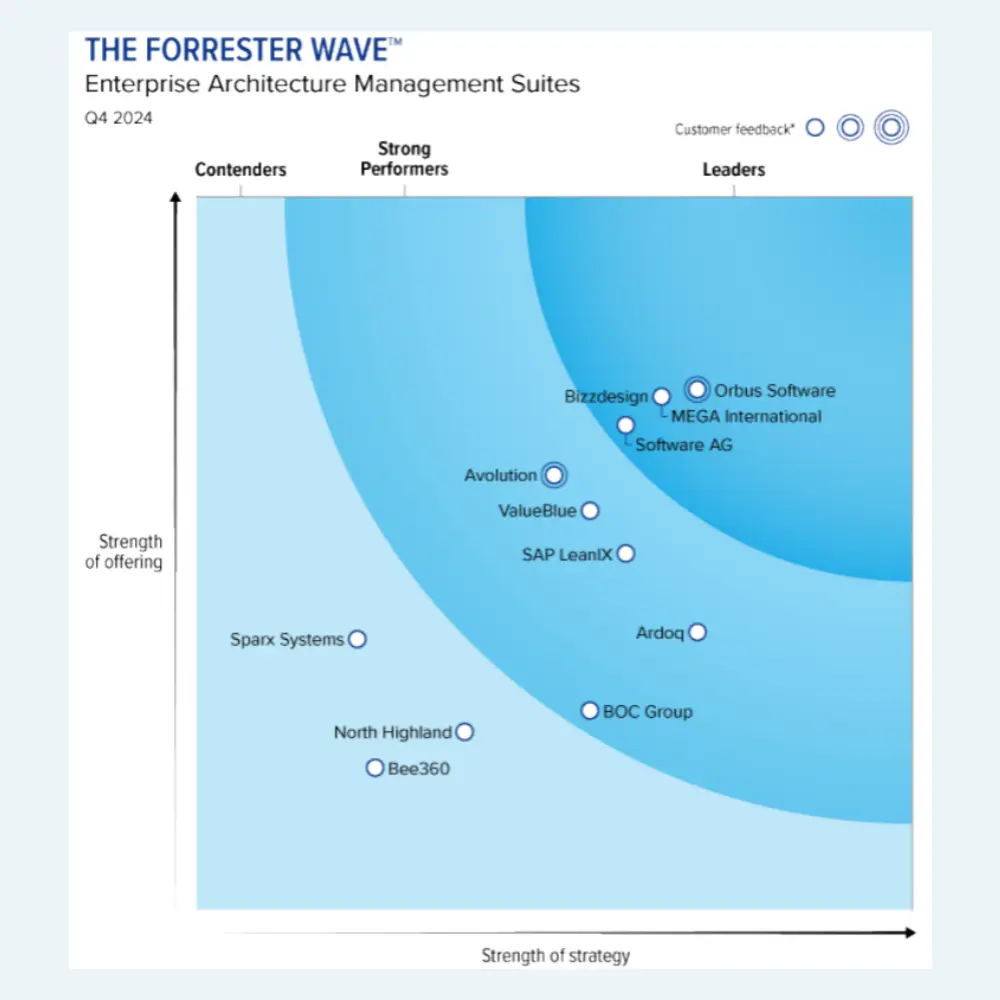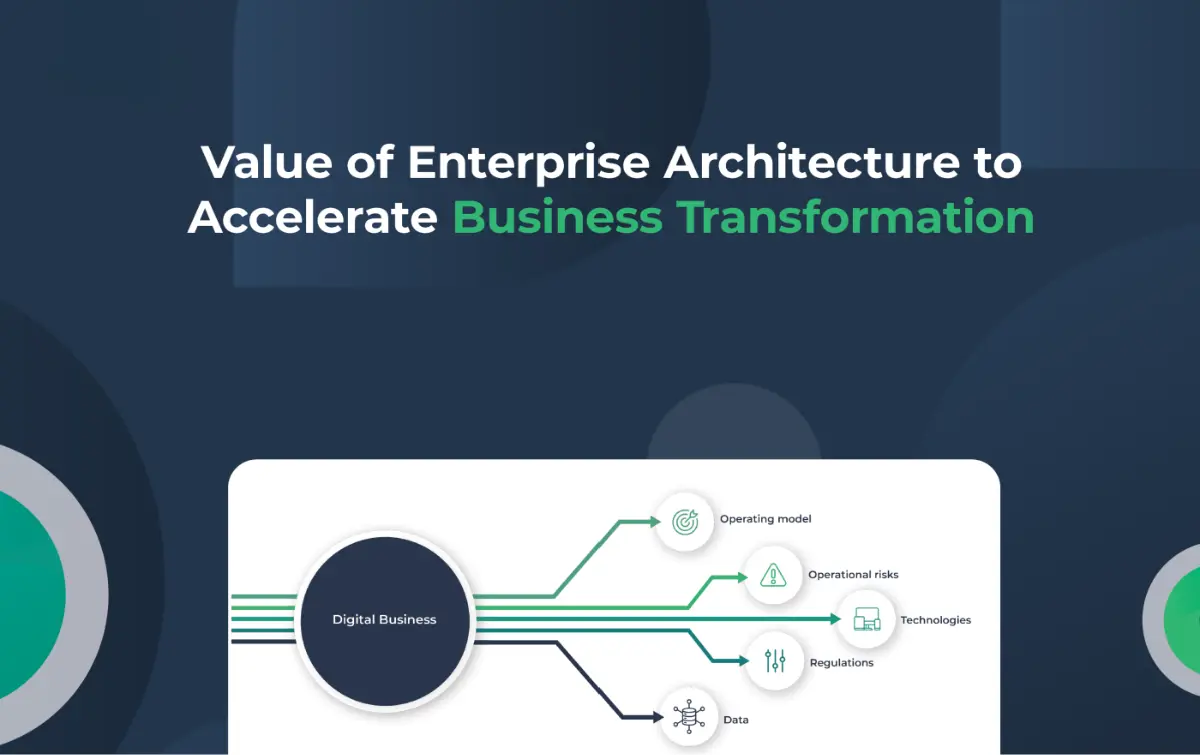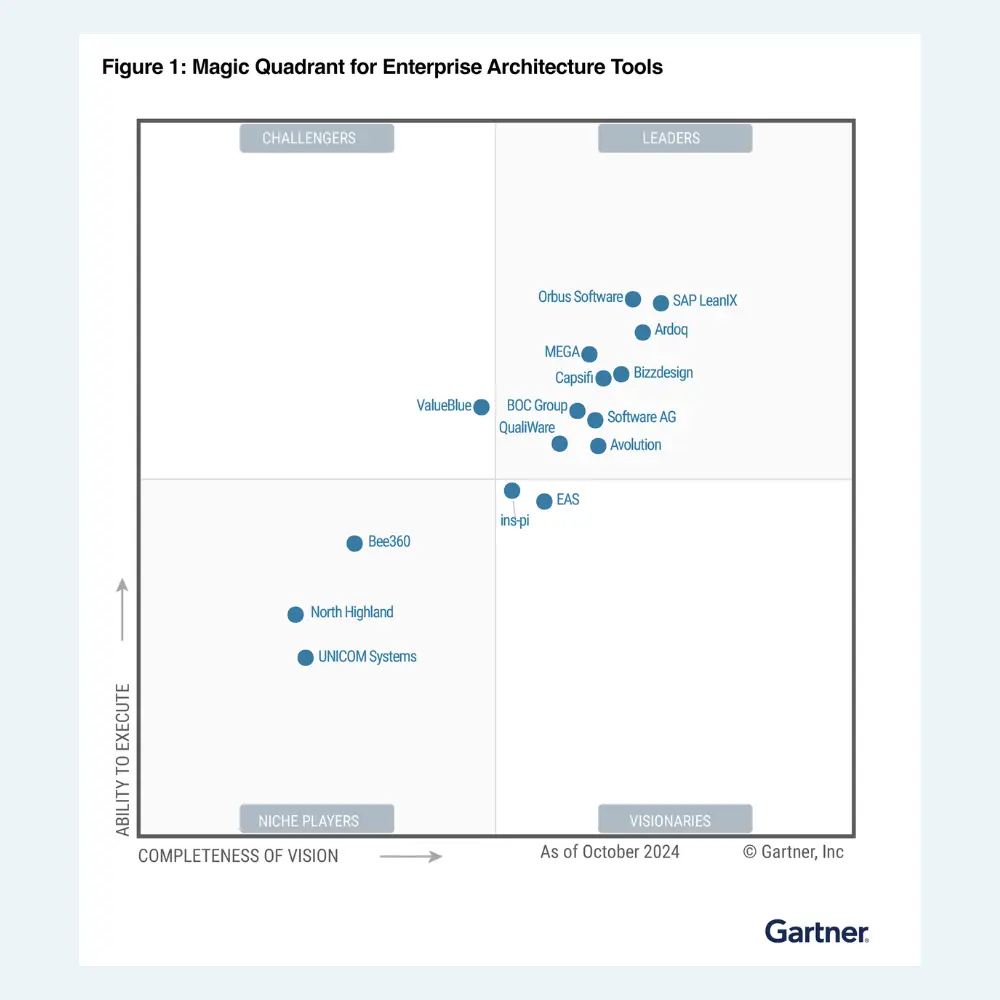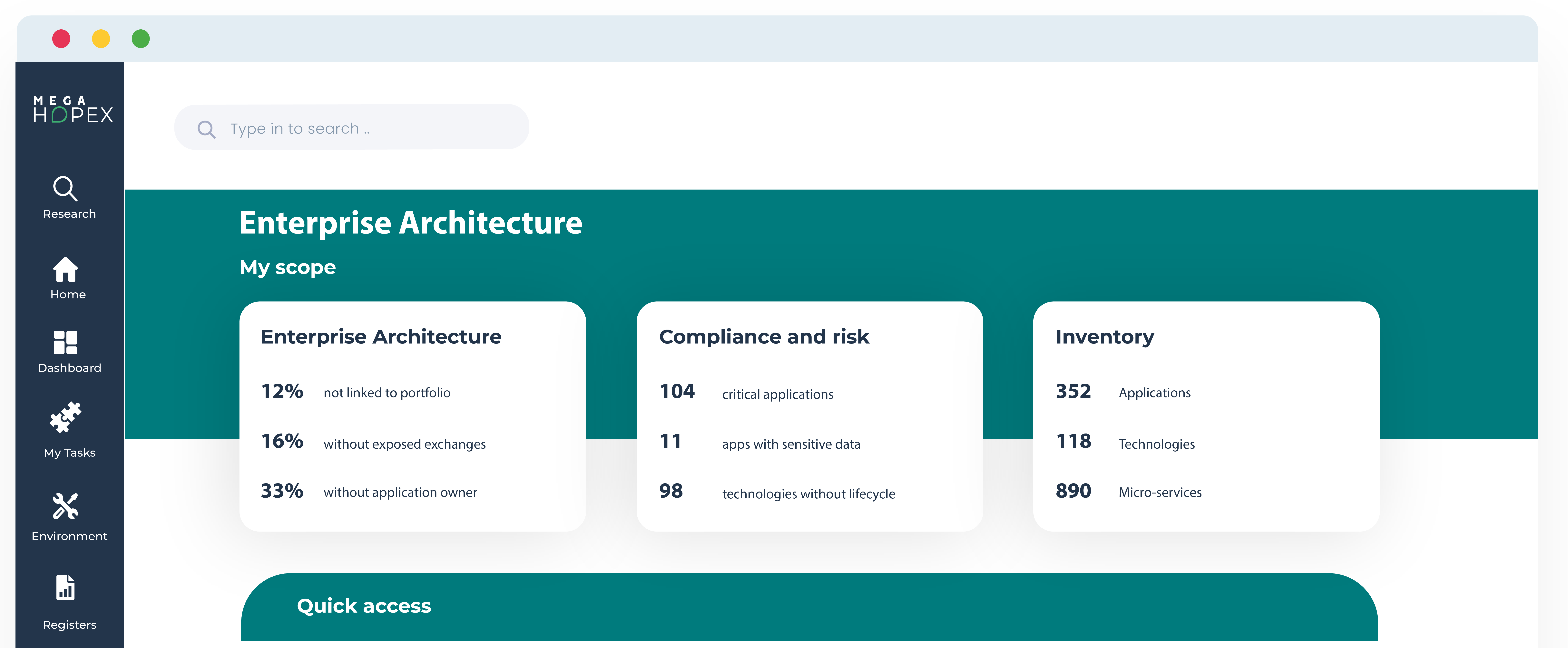
Ensuring the Success of Your Enterprise Architecture Initiatives
As part of the MEGA EA Exchange 2022 digital conference, experts Tara Castleberry, CEO at Creo Technology Services, and Dan Hebda, Chief Strategy Officer at MEGA International, discussed the value of enterprise architecture within organizations, highlighting the role of architects in helping transformation projects through effective communication, collaboration, and alignment of business needs and IT solutions.
Starting an Initiative - Pitfalls to Avoid and Tactics to Ensure a Higher Degree of Success
The conversation between Dan Hebda and Tara Castleberry began with Dan asking if Tara had any advice on what pitfalls to avoid and what tactics to use to ensure the success of an EA initiative.
Tara is of the opinion that enterprise architecture as a discipline has often struggled with delivery and is often perceived by stakeholders as being unrealistic. She believes business engagement is the best way to overcome these challenges.
According to Tara, the success of enterprise architecture depends on engaging with in-flight business activities and creating a partnership. The architecture capabilities need to be fluid to open up opportunities with services that are clearly defined. In this way, the success of the business mirrors the success of enterprise architecture. Tara points out that: “The business’s KPIs and their KRIs then become your value proposition as well.”
Establish Business Relationships and Move Away from Negative Perceptions
Dan posed the critical question: “How does an enterprise architect establish business relationships and get people to move away from negative perceptions?”
Architects need to talk to those in the Business. “Everybody has an architect in them” replied Tara. “When we look at architecture as a discipline, we can see that many people engaged in architecture have some pattern-based recognition skills, whether that's a mathematical element that makes them better suited to the technology space or a form of organizational, people, and process skills.
Removing architecture as a service itself and stepping back, we can see that these qualities are the building blocks for solid governance, risk, and compliance. Seeing this allows for the connectivity of people to the value of architecture.
So, ask about the problems. Architects should be driven by the problem itself and shouldn’t be isolated simply to technical domains. All it takes is one optimization of a business partner's workload and you have built a reputation for delivering value. You can grow from that and create an intake pipeline of people that are sharing their problems. Understanding these problems enables us to make enterprise architecture effective. We need to identify where the business strategy may be off-kilter or where the complexity of the technology landscape may be prohibitive to the advancements of the transformation that they're looking for.”
Dan elaborated on Tara’s concept by explaining MEGA International’s ‘noisy to influential’ approach. This methodology takes an EA practice and builds on that value delivery to find stakeholders that are receptive and promote the value of EA.
“As you generate success within one audience, others tend to take notice and want to participate in the value. Ultimately, you become influential and able to drive positive collaborative change within the organization.”
Ensure that an Organization Recognizes the Value of EA
Dan raised the point that enterprise architects may put in a lot of advanced work to ensure that a project will execute smoothly. However, at the end of the project, the project team receives full credit, and the work of the enterprise architect is overlooked. How can we ensure that organizations recognize the value of EA?
“Early engagement is key to recognized value. Often, five to seven different tools are introduced without architect engagement. These tools should be rationalized before being brought in and before moving forward on delivering a new capability. Businesses need to understand what they already have.
In many cases, simply by creating visibility, you can create economies of scale and change the culture of a company by teaching it that it’s working on the same tool. The capabilities aren't that different.”
Tara warned that people can push back if the tools they are accustomed to are changed or removed. To mitigate this, she advises enterprise architects to focus on creating relationships.
“Help clients to establish additional bridges that will connect them with the knowledge they need to advance their capabilities. All technology within an enterprise is something that everyone else should be able to embrace. That is the value proposition of the enterprise architect. They have an awareness of where knowledge lies and how to bring the right people to the table. This can result in meaningful conversations to drive out a direction that is collaborative in nature.”
Get Business Leaders to Agree on a Collaborative Evolution Process
The two experts moved on to issues that enterprise architects face when implementing changes to an organization’s IT structure. Dan mentioned that he found it interesting to compare economies of scale and the visibility that architects often have.
“I've talked to a lot of individuals who look at the potential for economies of scale and say, ‘yeah, it's great from the architecture side, but how do you get these different business leaders to agree on a direction?’” Dan stated that many stakeholders are reluctant to switch technology or change processes or other elements of their current business. What techniques can help facilitate a more collaborative evolution?
Tara’s advice was to locate the team that is vocal about their problems and find the teams that have solved those problems.
“These solution teams are usually passionate about their technical capabilities. Typically, this will not be the leader of an organization. It will be an employee that loves the use of a particular tool.
It is not the responsibility of an enterprise architect to break down those walls. It’s to make introductions between the teams that have problems and those that have already solved them. Organically, these teams often come together and realize there is a cost benefit, a collaborative benefit, and that they can start innovating together.
Enterprise architects should not be dictatorial, but instead, try to get people to recognize common denominators and motivations. This can build the momentum a business needs to enhance collaboration and encourage cultural change.”
Example of best practice: Facilitate Coordination Between IT Teams and Compliance Teams
Tara stressed the importance of facilitating coordination between IT teams and compliance teams. In her view, governance, risk, and compliance departments are at loggerheads with IT departments. Business leaders may be unsure of how to implement a regulatory requirement and granular technology teams often overcomplicate the process.
“There’s this beautiful space for Architects in the middle where you understand what the governance, risk, or compliance requirement may be and then tie that back to the technology team. It’s about a top-down approach and a bottom-up approach where you meet in the middle.”
Tara believes that security needs to know everything to effectively protect an enterprise. Likewise, Compliance needs to understand that all their issues are being addressed. Enterprise architects can become viable partners in connecting the dots and creating a smooth runway to enable adherence to changing compliance requirements, regulatory requirements, solvency requirements, and dynamically changing environments. She went on to say that this integrated risk management capability can be a value proposition that brings together all stakeholders.
Establish a Preliminary Baseline and Intake Process
The conversation then shifted gear as Dan asked about how to develop content to make the initiative work. “Do enterprise architects need a baseline?” he asked, “and once they have one, where do they go from there?”
Tara replied that EAs should first establish a loose baseline. “Even 80% of what you have is good enough. Do not fight for perfection. Avoid repeated iterations. Get something on the ground, something solid. While this can depend on the culture of the firm and its problems or objectives, IT portfolio management is usually a huge win.”
To highlight this, Tara explained that IT portfolio management enables teams from diverse backgrounds to see all the applications they have. Businesses can mitigate the risk of obsolescence in technology because they can automatically subscribe to data that alerts them to potential issues.
“In the IT portfolio management space, you can start to connect business objectives that relate to these applications, the capabilities, and the business process.
People know intuitively that everything is intrinsically connected. When presented with a conceptual picture of the entire ecosystem, people will find where they fit in and start to realize there is value 360 degrees around them, not just up and down.”
When solving problems, enterprise architects need to use their knowledge of technology and applications and their established personal relationships to craft the right solution for problems. Certain use cases may call for more diligence or rigor, but other use cases may be more conceptual.
“Create an intake process and bring other people in. This can help to avoid analysis paralysis and over-modeling. Issues can arise when everything is very technical and complex and not relatable to the business side. Realize that the business is your sponsor. They're paying for the architecture service. That value proposition should be assessed with every use case.
Identify the things that you're good at and what you should be doing. Start with an idea of what it is that you want to deliver. Focus on the capabilities that are important and then tool those. The organic growth within the tool will align with the organic growth of the organization and the willingness of contributors to be a part of the solution.”
Achieve Deliverables, Gauge Granularity, and Get Support for Initiatives
As the conversation drew to an end, Dan asked Tara if she had any final tips. Her response was that enterprise architects can provide tangible deliveries that technology departments can recognize, and business leaders can stand behind. She went on to provide some illuminating strategies on how EAs can achieve goals and be recognized for their work.
“Start with minimally viable metadata. Who owns the applications? What technologies do they depend on? What projects are changing these applications? How does this tie to the strategic objectives?
If we step back and constantly remind stakeholders that everything is intrinsically connected, they will see the pattern. This understanding allows you to define the minimum expansion and create iterations that will bring increasing value.
Define your services. Document what you know you can do as a team. Capture the knowledge, build a baseline, and focus on the minimally viable metadata. This will benefit the people coming in through your intake funnel. Frame it, but don't disallow fluidity. Be fluid. Be flexible.
To be effective in enterprise architecture, you need to find opportunities and motivations. Do not dictate and do not insert. Ask to be included in net new business decisions and find opportunities to engage so that you can run into your services and create a holistic value.”
Enterprise Architecture Related Content
Shift from a documentation tool to an operational tool and accelerate business transformation
MEGA HOPEX for Enterprise Architecture
Request a demonstration of HOPEX for EA, and see how you can have immediate value of your projects.







